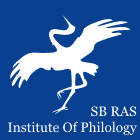 |
|
||||||||||||
|
Institute of Philology of
the Siberian Branch of Russian Academy of Sciences |
|
||||||||||||
|
|||||||||||||
| Sibirskii Filologicheskii Zhurnal (Siberian Journal of Philology) | |
|
Article
Authors: L. A. Shamina Institute of Philology SB RAS, Novosibirsk, Russian Federation In the section Linguistics
Abstract: In the Tuvan language, as in many other languages, there is a form that grammaticalizes the semantics of apprehensive and preventive. It is a form with -dy, which expresses the preven-tive semantics combined with the verb көөр in the 2nd person of the singular and plural and the interrogative particle be. It is known that Tuvan has no particular grammatical form to express the meanings concerned. However, we have found various means that are used for this purpose. The core of verbal analytical constructions with the semantics of caution is represented by constructs based on structural schemes, including the forms with -dy and delexicalized interjection-imperative halak. We have identified five basic structural types of grammaticalized analytical constructions representing a situation that might be about to happen or messages (warnings) indicating that some undesirable situations may occur. Among them, the form with -dy complicated by additional lexical and grammatical elements is the main marker of the semantics of caution. In general, the results of our study suggest that the semantics of caution is implemented in the Tuvan language by a combination of rhythmic-intonational, lexical, morphological, and syntactic means, with some forms or constructions used in certain conditions specified by the context. Keywords: verbal analytical constructions, grammaticalized constructions, imperative words, particles, apprehensive, preventive Bibliography: Dobrushina N. R. Grammaticheskie formy i konstruktsii so znacheniem opaseniya i predosterezheniya [Grammatical forms and structures with the meaning of the warning and caution]. Voprosy Jazykoznanija (Topics in the study of language). 2006, no. 2, pp. 28–67. Dobrushina N. R., Daniel’ M. A. Russkaya chastitsa smotri v tipologicheskom osve- shchenii [Russian particle “smotri” (see) in typological coverage]. In: Dinamicheskie modeli: Slovo. Predlozhenie. Tekst: Sb. st. v chest’ E. V. Paduchevoy [Dynamic Models: Word. Sentence. Text. Collection of articles in honor of E. V. Paducheva]. Moscow, LRC Publishing House, 2008, pp. 293–308. Grammatika kalmytskogo yazyka. Fonetika. Morfologiya [Grammar of the Kalmykian language. Phonetics. Morphology]. G. D. Sanzheev (Ed.). Elista, Kalm. kn. izd., 1983, pp. 205–234. Iskhakov F. G., Pal’mbakh A. A. Grammatika tuvinskogo yazyka [Grammar of the Tuvan language]. Moscow, Vost. lit., 1961, 472 p. Issledovaniya po teorii grammatiki [Studies on the theory of grammar]. Yu. A. Lander, V. A. Plungyan, A. Yu. Urmanchieva (Eds.). Moscow, Gnozis, 2004, iss. 3: Irrealis i real’nost’ [Irrealis and Reality]. 476 p. Mongush D. A. Formy proshedshego vremeni iz”yavitel’nogo nakloneniya v tuvinskom yazyke [Forms of the past tense of the indicative mood in the Tuvan language]. Kyzyl, Tuvknigoizdat, 1963, 167 p. Prokhorov K. N. Kalmytskie formy kosvennykh nakloneniy: semantika, morfologiya, sintaksis [Kalmyk forms of indirect moods: Semantics, Morphology, Syntax]. Acta Linguistica Petropolitana. Transactions of the Institute for Linguistic Studies. St. Petersburg, 2009, vol. 5, pt. 2, pp. 160–224. Rassadin V. I. Morfologiya tofalarskogo yazyka v sravnitel’nom osveshchenii [Morphology of the Tofalar language in comparative coverage]. Moscow, Nauka, 1978, 287 p. |
 |
Institute of Philology Nikolaeva st., 8, Novosibirsk, 630090, Russian Federation +7-383-330-15-18, ifl@philology.nsc.ru |
© Institute of Philology |


